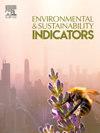Jajrud保护区生态网络结构与生物功能连续性分析
IF 5.4
Q1 ENVIRONMENTAL SCIENCES
引用次数: 0
摘要
城市生态功能的破碎化和退化是城市宝贵生态资源保护面临的主要威胁之一。控制这些地区土地破碎化和破坏的有效战略需要确定生态资源和生物功能。基于此,本研究在Jajrud保护区(PA)城区进行了敏感资源和生态资源的识别,绘制了生态网络图,并对该地区生物功能的连续性进行了研究。为此目的,根据绘制具有生态功能地区地图的两个数量标准确定了具有敏感资源(历史和文化纪念碑)和生态资源(植被、水资源和受伊朗环境部保护和管理的地区)的地区,其中包括根据地图比例尺划定的最小面积(25-200公顷)和对研究资料的审查。在此基础上,分析了人类活动导致的人为因素是该区主要的生态障碍。结果表明,该城市的主要敏感生态源包括国家公园(Khojir和Sorkheh Hesar)和PA。该地区的中部地区分布着更多的国家公园和生物保护区,具有更高的生态重要性,现在对城市化和人类活动的生物敏感性也更高。而生态价值资源分布较低、人类活动开发程度较高的北部和西北部地区则处于中、低重要程度。结果表明,敏感生物区权重最高,后续优先级分别为。同样,Jajrud PA的环境绩效分析表明,该地区的生态凝聚力在2000年至2023年间有所下降。由于Jajrud PA拥有一个生物敏感区域网络,因此必须规划并提供适当的工具来减少城市发展的影响及其威胁。作为一种管理解决方案,它可以帮助确保人类活动以及由此导致的环境危害和后果得到适当的保护和规划。本文章由计算机程序翻译,如有差异,请以英文原文为准。
Analysis of ecological network structure and biological function continuity in Jajrud Protected Area
Fragmentation and decrease of ecological function in urban areas are one of the major threats to the protection of valuable ecological resources. Effective strategies to control land fragmentation and destruction in these areas require the identification of ecological resources and biological functions. Accordingly, the present study identified sensitive and ecological resources and prepared an ecological network map in the Jajrud Protected Area (PA) urban set, and then examined the continuity of biological function in this area. For this purpose, areas with sensitive resources (historical and cultural monuments) and ecological resources (vegetation, water resources, and areas under protection and management of the Department of Environment of Iran) were identified based on two quantitative criteria for mapping areas with an ecological function, including a minimum area (25–200 ha) according to the map scale and a review of study sources. Then, man-made factors resulting from the development of human activities were examined as the main ecological obstacles in the area. According to the results, the main sensitive and ecological sources in this urban set include the national parks (Khojir and Sorkheh Hesar) and the PA. The central regions of the area, which have a greater distribution of national parks and biological reserves, have higher ecological importance and are now also more biologically sensitive to urbanization and human activities. In contrast, the northern and northwestern regions, which lower distribution of ecologically valuable resources and increased human activity development, are in the medium and low importance categories. According to the results, sensitive biological areas have the highest weighting and subsequent priorities are respectively. Similarly, the analysis of the environmental performance of the Jajrud PA shows that the ecological cohesion of the area decreased between 2000 and 2023. As the Jajrud PA has a network of biologically sensitive areas, it is essential to plan and provide the appropriate tools to reduce the impact of urban development and its threats. As a management solution, it can help to ensure that human activities and, consequently, environmental hazards and consequences are properly protected and planned.
求助全文
通过发布文献求助,成功后即可免费获取论文全文。
去求助
来源期刊

Environmental and Sustainability Indicators
Environmental Science-Environmental Science (miscellaneous)
CiteScore
7.80
自引率
2.30%
发文量
49
审稿时长
57 days
 求助内容:
求助内容: 应助结果提醒方式:
应助结果提醒方式:


